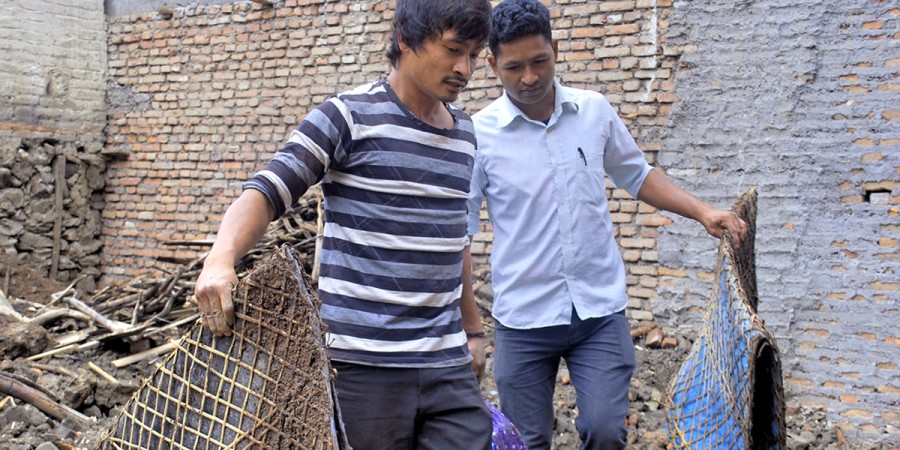There are two ways of looking at the earthquakes that struck in Nepal on 25 April and 12 May 2015. You can focus on the amount of devastation and heartache it caused for the many people who were affected and continue to be affected; or you can take what came out of this disaster and look at the positive cultural shifts it brought about.
Nepali society is ruled by a caste system culturally and traditionally. Those who are born as dalits (the ‘untouchables’) will always remain so; it is destined by birth. At the other end of the scale are the bramins, the teachers, professors, business people who are born with unscripted privileges that set them apart. There are many castes in between who have other destinies from traders to tradesmen; each caste with its own level in society.
Baburam Dankuti, 31, is a dalit from Gorkha district, the epicenter of the devastating 25 April earthquake and has lived his life in extreme poverty. After the earthquake Baburam and a number of volunteers helped people whose homes were damaged, many of whom trying to retrieve whatever items they could from the rubble. It was during this time when Baburam and his band of volunteers came to the assistance of Anil Shrestha, who now lives with his parents, grandparents and two sisters in a shack nearby. Despite weeks of monsoon rains, three months after the quake the two newly found friends extracted something useful from the rubble – a sack full of books and two “ghums” (traditional raincoat made of bamboo, leaves and polythene). “We’ll plant rice on the debris,” giggled Anil, 20, an undergraduate student of management – Baburam, standing alongside, smiled. “No, no… we’ll build a new house right here,” Anil corrected his earlier statement.
In a society where the caste system is still deeply ingrained, the kind of jovial atmosphere between the two men would not be a common occurrence prior to the earthquake. Baburam hails from the dalit community, while Anil to the slightly upper caste newar, in the conservative caste hierarchy of Nepal. Baburam is a junior officer at the Government’s Dalit Development Committee, and swung into action within minutes of the first earthquake. Three months later, he is still on the ground helping thousands in Gorkha as well as other affected districts in Kathmandu, Nuwakot, Dhading, Dolakha, Ramechhap and Sindhupalchowk. Baburam tells the United Nations Office for Humanitarian Affairs (UN OCHA) he was never treated differently by the beneficiaries or his fellow volunteers – most of who are from the upper castes. “I have been to the destroyed houses of all castes; we worked together, ate together; I would tell them I am a dalit,” he said, during an interview. “The issue of caste never came into play.”
Most of Baburam’s post-quake aid work was under the banner of a non-governmental organization called HEADS-Nepal (Health, Education and Agriculture Development Society), of which he is a member. He added that HEADS-Nepal deployed 101 volunteers, with only two members from the dalit community. “It gives you a special feeling when you carry a wounded person to the hospital for treatment or are able to bring a smile to the face of someone crying,” said Baburam who rescued a victim half-buried under the rubble and brought him to the hospital within 20 minutes of the quake. “We saw a labourer on the road crying and struggling to free himself from the marble that had fallen on him. We pulled him out and immediately brought him to the hospital,” said Baburam. “My life has been a life of deprivation – when I was growing up we needed to supplement our food and relied on the goodness of others to survive. Being a member of the dalit community, I have a big heart although I may not have a lot of money.” Against the odds Baburam obtained a masters’ degree in political science from Nepal’s Tribhuvan University through sheer hard work and determination. He thinks that the earthquake brought a valuable lesson: that nature does not discriminate against rich or poor, higher or lower caste.
Similar is the story of Bishnu Maya Pariyar, a rights activist from the Gorkha district who currently lives in the United States. Ms. Pariyar’s life story was the subject of a 15-minute documentary film “Untouchable” by a US filmmaker Kevin Neynaber. Two weeks after the Nepal quake, Bishnu Maya who founded in the US the charities Empower Dalit Women of Nepal (EDWON) and Women for Cause, travelled to her native village, Taklung, and distributed relief aid to thousands. “I am heartbroken after seeing my parent’s destroyed house where I was born and grew up. Hundreds of thousands Nepalese are going through the same pain and suffering like me. I pray that no one should suffer again like this. Let’s rebuild Nepal. Let’s keep our hope and spirit alive. We will be stronger than ever. The bright future is ours,” she wrote on her Facebook wall on 16 May, five days after arriving in Nepal.
On 24 July, in recognition of Bishnu Maya’s work in support of Nepal’s earthquake victims, the United States Jersey City’s, Mayor Steven Fulop recognized her outstanding work and the work of the organization she started, Women for Cause at a ceremony in her honour. The focus on listening to the community and hearing what they have to say in the aftermath of a disaster is vitally important. The last of the World Humanitarian Summit Consultations being held in Dushanbe is about people like Baburam Dankuti and Bishnu Maya Pariyar, who contribute so much to their community’s recovery.
Follow the regional consultation in Dushanbe over the WHS livestream!
NB: This post was written by Tilak Pokharel


Comments